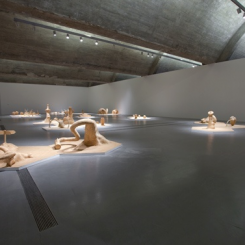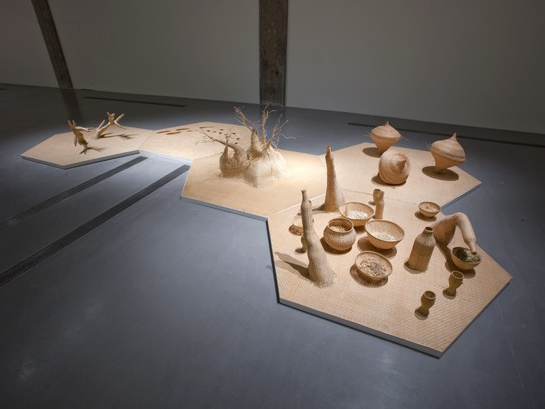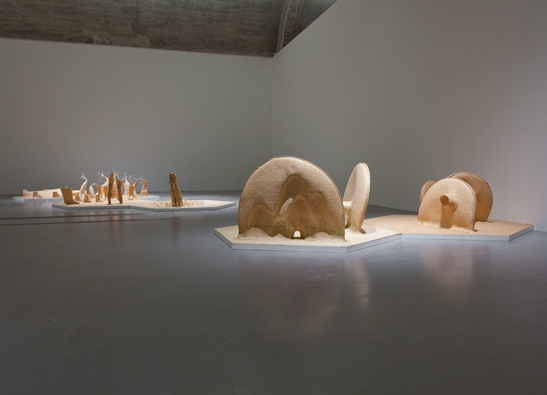SZ: This exhibition is titled “Cell”; what are you trying to reveal through this diction? The cell is the basic unit of the activity of life, and the material of bamboo itself is a product of nature. If the project involves a form of human labor in which the hand participates, how does the work weave this together with the natural growth and propagation of the material?
QZJ: “Cell” refers to the way in which each work in the exhibition space constitutes an individual cell distinct from any other, while they also together constitute an organism. At the same time, it also emphasizes a sensation of spreading or multiplying, just as each of the works here is formed through slow handiwork.
- SZ: How does this exhibition use the Pace Beijing exhibition space? Could you briefly describe how the concept of your work is manifested on site?
QZJ: The on-site manifestation of the work was determined early on: several dozen bamboo mats woven into modeled objects are installed on hexagonal bases. Only the floor of the gallery is used, with the walls left completely empty. The bases are low, so it seems that the objects have grown directly out of the floor. Each bamboo mat work can exist independently, or they can enter into all kinds of relationships in a beehive formation. This will be determined randomly while setting up the exhibition.
SZ: Works like the “Nanjing Yangtze River Bridge” and “Colorful Lanterns of the Shangyuan Festival” have manifested a literati understanding of time and space, involving also the experience and pursuit of extreme feelings like birth and death, sickness and aging, sorrow and joy, parting and reunion. Is this a central thread in the genealogy of your work? Do you find any contradiction between the core of the Chinese literati spirit and the creative methods of contemporary art?
QZJ: Yes, we might say that the “sighing” approach to life found in the Chinese literati’s approach to time and space—which we see in sayings like “[life is as passing as] the footprints of birds in the sand,” “as ephemeral as a fleeting cloud,” and “our descendants will one day look back at us as we today view our ancestors”—constitutes a core thread of my practice.
“The Nanjing Yangtze River Bridge Project” was primarily intended to deal with the value system that says “even common people cannot be deprived of their will,” and to reflect upon the monumentality of large-scale construction projects. Great revolutions always kidnap the fate of the common people with ideals, whether this grand ideal is called “revolution” or, as we find today, “success.” Traditional Chinese thinking has a profound ability to face the void in terms of its approach to power, and a profound sense of empathy and appreciation toward the defeated. Ambition and supremacy, no matter how great, ultimately end up as objects of commemoration. Common people, like bamboo, bend and bow in the face of a strong wind, but do not break; when the wind passes, they stand straight again.
“Qiu’s Notes Project: Colorful Lanterns of the Shangyuan Festival” moves in a similar direction by exploring the latent texts of the theater of the history of sketching, seeking certain genetic traits. The basic structure of such historical stories is acted out again and again in various different eras, including our present age.
As such, my interpretation of Chinese culture emerges from contemporary questions, and the use of contemporary modes of production in terms of form is also necessary in a certain way—there is no contradiction here. The problem is that the methods of contemporary art remain too simple, not subtle enough, and have produced a contemporary audience that brusquely and blindly worships fashion.





